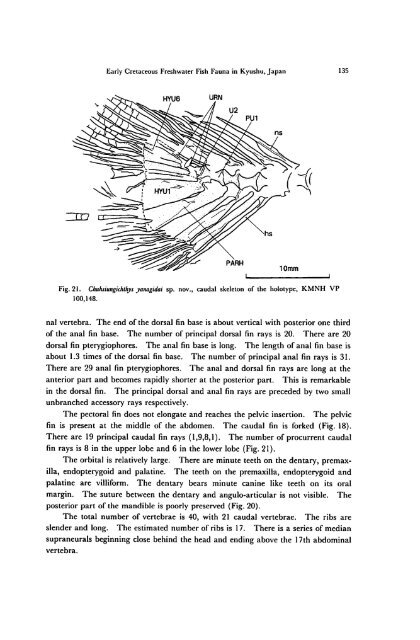Early Cretaceous Freshwater Fish Fauna in Kyushu, Japan
Early Cretaceous Freshwater Fish Fauna in Kyushu, Japan
Early Cretaceous Freshwater Fish Fauna in Kyushu, Japan
You also want an ePaper? Increase the reach of your titles
YUMPU automatically turns print PDFs into web optimized ePapers that Google loves.
<strong>Early</strong> <strong>Cretaceous</strong> <strong>Freshwater</strong> <strong>Fish</strong> <strong>Fauna</strong> <strong>in</strong> <strong>Kyushu</strong>, <strong>Japan</strong> 135<br />
URN<br />
Fig. 21.<br />
100,148.<br />
Chuhsiungichthys yanagidai sp. nov., caudal skeleton of the holotype, KMNH VP<br />
nal vertebra. The end of the dorsal f<strong>in</strong> base is about vertical with posterior one third<br />
of the anal f<strong>in</strong> base. The number of pr<strong>in</strong>cipal dorsal f<strong>in</strong> rays is 20. There are 20<br />
dorsal f<strong>in</strong> pterygiophores. The anal f<strong>in</strong> base is long. The length of anal f<strong>in</strong> base is<br />
about 1.3 times of the dorsal f<strong>in</strong> base. The number of pr<strong>in</strong>cipal anal f<strong>in</strong> rays is 31.<br />
There are 29 anal f<strong>in</strong> pterygiophores. The anal and dorsal f<strong>in</strong> rays are long at the<br />
anterior part and becomes rapidly shorter at the posterior part. This is remarkable<br />
<strong>in</strong> the dorsal f<strong>in</strong>. The pr<strong>in</strong>cipal dorsal and anal f<strong>in</strong> rays are preceded by two small<br />
unbranched accessory rays respectively.<br />
The pectoral f<strong>in</strong> does not elongate and reaches the pelvic <strong>in</strong>sertion. The pelvic<br />
f<strong>in</strong> is present at the middle of the abdomen. The caudal f<strong>in</strong> is forked (Fig. 18).<br />
There are 19 pr<strong>in</strong>cipal caudal f<strong>in</strong> rays (1,9,8,1). The number of procurrent caudal<br />
f<strong>in</strong> rays is 8 <strong>in</strong> the upper lobe and 6 <strong>in</strong> the lower lobe (Fig. 21).<br />
The orbital is relatively large. There are m<strong>in</strong>ute teeth on the dentary, premax<br />
illa, endopterygoid and palat<strong>in</strong>e. The teeth on the premaxilla, endopterygoid and<br />
palat<strong>in</strong>e are villiform. The dentary bears m<strong>in</strong>ute can<strong>in</strong>e like teeth on its oral<br />
marg<strong>in</strong>. The suture between the dentary and angulo-articular is not visible. The<br />
posterior part of the mandible is poorly preserved (Fig. 20).<br />
The total number of vertebrae is 40, with 21 caudal vertebrae. The ribs are<br />
slender and long. The estimated number of ribs is 17. There is a series of median<br />
supraneurals beg<strong>in</strong>n<strong>in</strong>g close beh<strong>in</strong>d the head and end<strong>in</strong>g above the 17th abdom<strong>in</strong>al<br />
vertebra.

















